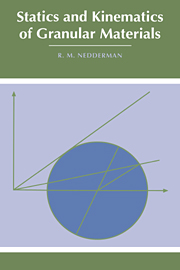Book contents
- Frontmatter
- Contents
- Notation
- 1 Introduction
- 2 The analysis of stress and strain rate
- 3 The ideal Coulomb material
- 4 Coulomb's method of wedges
- 5 The method of differential slices
- 6 Determination of physical properties
- 7 Exact stress analyses
- 8 Velocity distributions
- 9 The Conical yield function
- 10 The prediction of mass flow rate
- Set problems – chapters 2–10
- Appendices
- References and bibliography
- Index
4 - Coulomb's method of wedges
Published online by Cambridge University Press: 28 October 2009
- Frontmatter
- Contents
- Notation
- 1 Introduction
- 2 The analysis of stress and strain rate
- 3 The ideal Coulomb material
- 4 Coulomb's method of wedges
- 5 The method of differential slices
- 6 Determination of physical properties
- 7 Exact stress analyses
- 8 Velocity distributions
- 9 The Conical yield function
- 10 The prediction of mass flow rate
- Set problems – chapters 2–10
- Appendices
- References and bibliography
- Index
Summary
Introduction
In this chapter we will consider a series of analyses based on the Method of Wedges. This method dates back to Coulomb's original work of 1773, though changing fashions in the presentation of algebra makes the following account quite different from Coulomb's original version.
We have already used the method in a simplified form in §3.6 but without any comments on its validity. An attempt is made in §4.6 to justify the use of the method and to discuss its accuracy. First, however, we will consider a few classic results in §4.2 to §4.4 and then adapt the method for some novel situations in the remaining section of this chapter.
It must be appreciated from the onset that the method is strictly applicable to two-dimensional situations only and it is therefore best used for the prediction of the force on a planar retaining wall of infinite extent. We will, however, extend the method to the case of parallel walls in §4.8. Attempts have been made to adapt the method to three-dimensional situations such as bunkers of rectangular or circular cross-section. None of these is wholly satisfactory and in this chapter we will confine ourselves to effectively two-dimensional systems. Consideration of the stress distribution in cylindrical bunkers is therefore deferred to the next chapter.
Force exerted by a cohesionless material on a vertical retaining wall
Let us first consider a vertical retaining wall supporting a cohesionless granular material with a horizontal top surface as shown in figure 4.1.
- Type
- Chapter
- Information
- Statics and Kinematics of Granular Materials , pp. 47 - 83Publisher: Cambridge University PressPrint publication year: 1992
- 1
- Cited by

